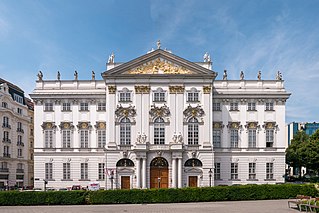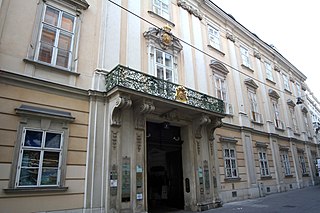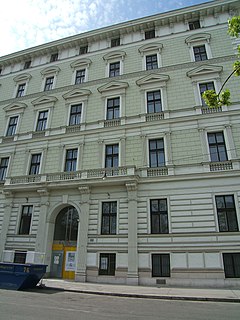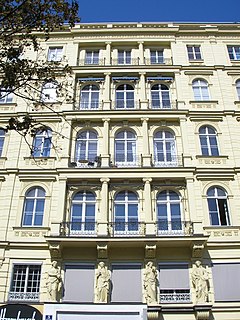
Palais Lieben-Auspitz is a Ringstraßenpalais in Vienna, Vienna, located in the city's Innere Stadt. [1]

Vienna is the federal capital, largest city and one of nine states of Austria. Vienna is Austria's primate city, with a population of about 1.9 million, and its cultural, economic, and political centre. It is the 7th-largest city by population within city limits in the European Union. Until the beginning of the 20th century, it was the largest German-speaking city in the world, and before the splitting of the Austro-Hungarian Empire in World War I, the city had 2 million inhabitants. Today, it has the second largest number of German speakers after Berlin. Vienna is host to many major international organizations, including the United Nations and OPEC. The city is located in the eastern part of Austria and is close to the borders of the Czech Republic, Slovakia, and Hungary. These regions work together in a European Centrope border region. Along with nearby Bratislava, Vienna forms a metropolitan region with 3 million inhabitants. In 2001, the city centre was designated a UNESCO World Heritage Site. In July 2017 it was moved to the list of World Heritage in Danger.

The Innere Stadt is the 1st municipal District of Vienna located in the center of the Austrian capital. The Innere Stadt is the Old Town of Vienna. Until the city boundaries were expanded in 1850, the Innere Stadt was congruent with the city of Vienna. Traditionally it was divided into four quarters, which were designated after important town gates: Stubenviertel (northeast), Kärntner Viertel (southeast), Widmerviertel (southwest), Schottenviertel (northwest).
Originally built for the Auspitz family in the 1872, [2] later the Lieben family also lived there. Unlike traditional, baroque noble palaces in Vienna, the Palais Lieben-Auspitz was built in the late 19th century and is therefore called a Ringstraßenpalais. It is up to five storeys high and built in the neo-baroque style typical of its time.
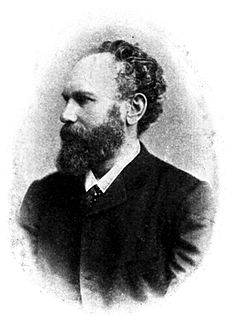
Carl Heinrich Auspitz was a Jewish Austrian dermatologist. He was the husband of pianist Auguste Auspitz-Kólar (1843–1878).
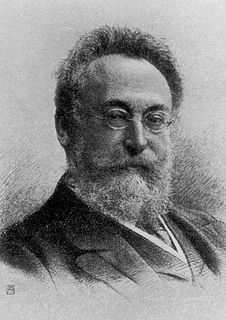
Adolf Lieben was an Austrian Jewish chemist. He was born in Vienna the son of Ignatz Lieben. He studied at the University of Vienna, University of Heidelberg, and Paris, and subsequently held the positions of privat-docent at the University of Vienna (1861), and professor in the universities of Palermo (1863), Turin (1867), and Prague (1871). From 1875 until his death he held the chair of general and pharmacological chemistry at the University of Vienna, and is a member of the Vienna Academy of Sciences.

The Baroque is a highly ornate and often extravagant style of architecture, music, dance, painting, sculpture and other arts that flourished in Europe from the early 17th until the mid-18th century. It followed the Renaissance style and preceded the Rococo and Neoclassical styles. It was encouraged by the Catholic Church as a means to counter the simplicity and austerity of Protestant architecture, art and music, though Lutheran Baroque art developed in parts of Europe as well. The Baroque style used contrast, movement, exuberant detail, deep colour, grandeur and surprise to achieve a sense of awe. The style began at the start of the 17th century in Rome, then spread rapidly to France, northern Italy, Spain and Portugal, then to Austria and southern Germany. By the 1730s, it had evolved into an even more flamboyant style, called rocaille or Rococo, which appeared in France and central Europe until the mid to late 18th century.
The palace housed the Salon of Berta Zuckerkandl, a meeting place for intellectuals and artists. Located on the street level is the Café Landtmann.
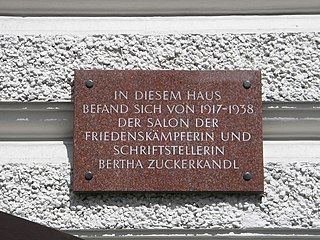
The Salon of Berta Zuckerkandl-Szeps existed in Vienna from the end of the 19th century until 1938. It was located in her Viennese residence in the Palais Lieben-Auspitz on the Ringstraße.
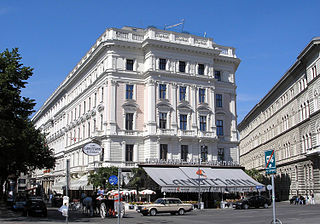
Café Landtmann is a traditional Viennese café located on the Ringstraße at the corner of Lowelstraße 22 in the Innere Stadt first district in Vienna, Austria.
